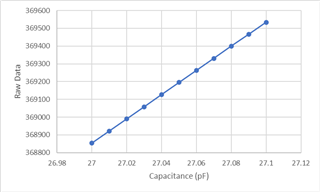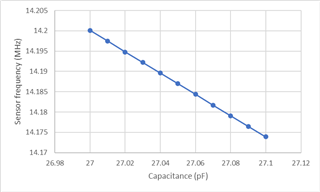Other Parts Discussed in Thread: LDC3114, FDC2214
Dear TI experts,
Based on this application report (https://www.ti.com/lit/an/snoa970/snoa970.pdf), I want to use the LDC3114 to measure the capacitance change of a parallel plate capacitive sensor at frequencies of 5, 10, 15, 20, 25 and 30 MHz.
Applications mainly involve measuring changes in relative permittivity and conductivity of the complex dielectric at different frequencies.
The capacitance change tested by the FDC2214 is approximately 0.01 to 0.1pF at 3MHz. However, since FDC can only go up to 10MHz, for testing at higher frequencies, LDC was considered.
So my question is how do I know the minimum capacitance change that the LDC3114 can measure?
Also, the LDC3114 has an input pin capacitance, does this need to be taken into account when calculating the expected oscillation frequency?
Best regards,
Will



